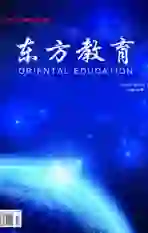Breaking down the Dichotomized Logocentric Conceptions in Translation
2018-06-11沈华东
摘要:傳统的二元对立思想立场已经越来越丧失其在人们心目的地位,于翻译领域亦是如此。绝对权威、忠实、确定性、意义以及对等这些概念,其实都是逻各斯中心主义的产物。在实际翻译过程中,译者唯有挣脱这些理念束缚,才能客观、辩证、灵活地完成翻译任务。
关键词:解构;权威;确定性;意义;忠实;对等
Introduction
Deconstruction cannot be considered as a translation theory, and it is even not a concrete method; however, it breaks down the traditional dichotomized logocentric conceptions, thus opening new avenues for thoughts. Generally speaking, the basic ideas of deconstructionism in translation studies can be summarized as follows:
I. Breaking down Absolute authority
Throughout the history of translation and translation studies, people have been striving for discovering the universal rules of translation so as to, as they claimed, make what I. A. Richards called “[probably] the most complex type of event yet produced in the evolution of the cosmos” (Richards, 1953: 250; cited in Gentzler, 2004: 14) more controllable and manageable. However, such a goal is not only unachievable, but also against humanity, because, on the one hand, universality calls for purity, but unfortunately, in the real world, purity of any kind is just a fiction—even the name of God is not originally pure, how, then, can we achieve purity in human activities such as translation? On the other hand, universality means domination, one rules all, and it wipes out all the otherness, hence tyrannical. So when someone says what he or she holds or promotes is universally applicable, it should be refuted.
II. Breaking down Fidelity
Translators in the contemporary time, no matter how vicarious they feel about the source text, can never be able to restore exactly the sense of the original author in the past. Moreover, translation never occurs in a vacuum, there are always social and cultural elements involved; thus, the fidelity that we translators are often so devoted to offer eventually disseminates and dissolves—the initiator, the original author, the target receiver and the translator are all the existences of a changing world where everything is transforming, transferring and translating as well as being transformed, transferred and translated. Intertexualtiy also helps break down the notion of fidelity. Texts make references to other texts, neither the source text author nor the source text is sacred and purely original, and in doing translation, translators have already been operating on intertexuality. Therefore, in this sense, keeping fidelity is ultimately a wishful struggle in the sea of intertexuality.
III. Breaking down Certainty
Texts are never saturable, and they are constantly recontexualized. Now that texts can function by nonsaturable means in recontexualization, they have no certain shapes and cores. Texts are produced and interpreted under the comprehensive influence of various elements and forces. The styles and genres of texts are not fixed, and information that a text conveys differs in different contexts. For instance, the styles and genres of todays newspaper articles are different from those published 20 years ago; the style and the linguistic expressions in Zhang Guruos (张谷若) translations of Charles Dickens works are different from those in Lin Shus(林纾).
IV. Breaking down Meaning
Language is a chain of signifiers (in Saussures terms), and the signified concept is never present. Moreover, language always differs spatially and defer temporally. Contextuality and historicity enable it to change over different circumstances; hence, meaning is an effect of language, not a prior presence (the signified) merely expressed in language. Thus, apart from the series of entries listed on various dictionaries, meaning becomes the simultaneous effect of language interacting with contexts (spatial and temporal), and there is no original, fixed presence of meaning. Meaning is generated during the process of translation and interpretation, then differs and defers, as the message of the text disseminates.
V. Breaking down Equivalence
As mentioned above, texts are uncertain with no fixed, prior presence of meaning, and the source text and the target text, which traditional metaphysics mechanically binds to the either side of the equal sign, are being constantly contextualized and recontexualized. Different translators may interpret the source text differently and render it into different versions; meanwhile, the target text faces different receivers and contexts, which eventually generate different interpretations; hence, either side is immeasurable in the traditional metaphysical sense—the equation cannot stand in reality. However, it is not to say that translators can do whatever they want in producing the target text—they just follow the reality and openly let the contextuality and historicity of the text manifest in unsaturated, diverse ways.
Conclusion
Languages are never pure—they are undergoing constant transformations. As practitioners working on different languages and texts, translators should be acutely aware of this fact and realistically, come up with practical strategies in accordance with different contexts. It should be emphasized that no translation theory or strategy is universally applicable, nor statically unalterable. In a time when harmony in diversity becomes more and more accepted among different populations, I believe that new and different thoughts, sometimes unavoidably superficial though, are always welcomed and considered as matrixes to generate more new ideas.
References:
[1]Davis, Kathleen. Deconstruction and Translation [M]. Shanghai: Shanghai Foreign Language Education Press, 2004.
[2]Derrida, Jacques. Des Tours de Babel [R], trans. Joseph F. Graham in Difference in Translation, ed. Joseph F. Graham: 219-227. New York: Cornell University Press, 1985.
[3]Gentzler, Edwin. Contemporary Translation Theories (Revised Second Edition) [M]. Shanghai: Shanghai Foreign Language Education Press, 2004.
[4]蔡新樂. 翻译与自我:德里达《死结》的翻译学解读与批判[M]. 北京: 中国社会科学出版社, 2008.
作者简介:沈华东,宁波大红鹰学院公共外语教学部讲师,研究方向:翻译理论与实践;跨文化比较,邮编:315175。
